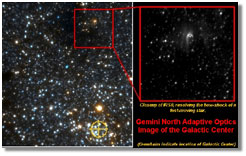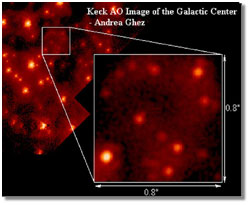
Fact Sheet

Resources for Reporters: Adaptive Optics Images & Features

1. Galileo's glasses: adaptive optics advances astronomy.
Adaptive optics for astronomy uses adjustable mirrors and computerized controls to compensate for the optical distortions caused by turbulence from heat and moisture in the earth's atmosphere. Turbulence is measured several hundred times a second by a wavefront sensor detector, using as a reference a bright natural star near the astronomical object being observed (in this case a faint galaxy). A real-time computer calculates what voltages to apply to a small deformable mirror, located behind the main telescope mirror, to adjust its surface to correct for the turbulence. Light from both the natural guide star and the faint astronomical object is reflected from the deformable mirror, which removes the optical distortions. With adaptive optics, astronomers predict that sophisticated ground-based telescopes will be able to capture images of planets in nearby planetary systems that so far have only been detected by indirect means such as gravitational wobbling. Image credit: Center for Adaptive Optics/NSF. This and other images are available from the center at http://www.ucolick.org/%7Ecfao/index.html.
|

Here is a larger version of the image.
|
2. Gemini North explores collisions near the galactic center.
The first scientific observations with adaptive optics from the Gemini North telescope atop Mauna Kea, Hawaii, provide a dramatic glimpse into the elusive core of the Milky Way, including an intriguing bow-shock from a star as it plows into a poorly understood gas cloud a mere 3 light-years from the galactic center. As light passes through the adaptive optics instruments on Gemini North, the distortions are measured at about 1,000 times per second and transmitted to instruments that adjust the shape of the deformable mirror. For more information, see press release at http://www.nsf.gov/od/lpa/news/press/00/pr0075.htm. Image credit: Gemini Observatory/ NSF/University of Hawaii Adaptive Optics Group. This and other Gemini North images are available at http://www.gemini.edu/public/adaptive.html.
|
 |
3. Keck examines stars in the center of our galaxy.
Astronomer Andrea Ghez of UCLA used high spatial resolution images from the W.M. Keck Observatory's 10-meter Keck I telescope atop Mauna Kea in Hawaii to produce maps of the galactic center at near-infrared wavelengths. With adaptive optics, Ghez and her colleagues obtained the most detailed observations yet of the stars that swirl around the supermassive black hole thought to reside at our galaxy's core, and to pinpoint the hole's location, known as Sagittarius A, about 26,000 light-years from Earth. Comparison of this adaptive optics image with earlier images of the region show the orbits of three stars around our galaxy's central black hole. Because the atmosphere distorts the images of stars, Ghez's technique used thousands of quick, high-resolution snapshots that corrected for the distortions. The results have been published in the journal Nature. Image credit: Andrea Ghez/Keck Observatory. Image can be obtained at: http://www.ucolick.org/%7Ecfao/pgallery/gc.html. |
 |
4. Dunn Solar Telescope shows fine details of the sun's surface.
High-resolution observations of small magnetic fluctuations on the sun's surface have become increasingly important for solving problems in solar physics. Adaptive optics reveal an amazing amount of fine structure in the solar atmosphere due to magnetic flux tubes and surface convection. These images of the solar granulation, taken simultaneously with and without adaptive optics, show the improvement that can be achieved. Images of this quality are rare and are observable only from ground-based telescopes because of the need for a large aperture. In order to study the physics of flux elements, or solar fine structure in general, spectroscopy and polarimetry of the fine structure are required. The exposure times needed are typically on the order of a few seconds, and adaptive optics is required to "freeze" the image and prevent blurring of the fine-scale features. Image credit: National Solar Observatory/NSF. More images and video are available at http://www.sunspot.noao.edu/AOWEB.
|
 |
5. Adaptive optics reveals the cone receptors in a human retina.
David Williams, director of the University of Rochester's Center for Visual Science and Austin Roorda, professor of optics at the University of Houston, are using adaptive optics to explore the optical quality of the eye and the organization of the human retina. Just as starlight is distorted when it passes through Earth's atmosphere, light is bent as it passes through the pupil. The researchers measure the aberrations of the eye with a wavefront sensor and use the measurements to control the shape of a deformable mirror. This mirror can be warped into the appropriate shape to correct most of the eye's aberrations, providing the eye with the best image quality ever achieved. Researchers have been able to resolve features at the spatial scale of single cells for the first time in the living retina. The right image shows the mosaic of cone photoreceptors in the living eye taken through adaptive optics. This ability has the potential to help with the diagnosis and treatment of retinal disease. Image credit: Austin Roorda/NSF. This and other images available at: http://www.cvs.rochester.edu/people/d_williams/d_williams.html and http://www.opt.uh.edu/research/aroorda/ao_res.htm. |
 |
6. In the future, adaptive optics could even be used to correct vision.
Wavefront sensing has potential applications in improving contact lens design and laser refractive surgery. Heidi Hofer, a graduate student in optics at the University of Rochester, shows, in the top row, the retinal image that results from correcting an eye's aberrations with conventional spectacles. The bottom reveals how much better the retinal image would be if the eye were corrected with adaptive optics instead of glasses. The wave aberration, a map of the pupil showing how fast light can travel through different parts of the pupil, is much flatter. This model assumed the letter E projected on the retina was about the same size as the retinal image of a fingernail held at arms' length. Image credit: Heidi Hofer/NSF. Image available from Heidi Hofer at (716) 275-8143 or heidi@optics.rochester.edu.
|
 |
For further information and images, contact Amber Jones, NSF, at (703) 292-8070/aljones@nsf.gov

|
![]()






![]()